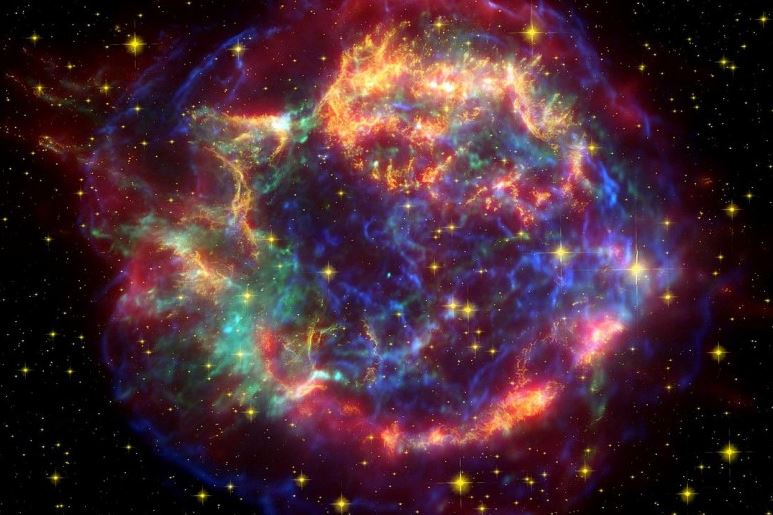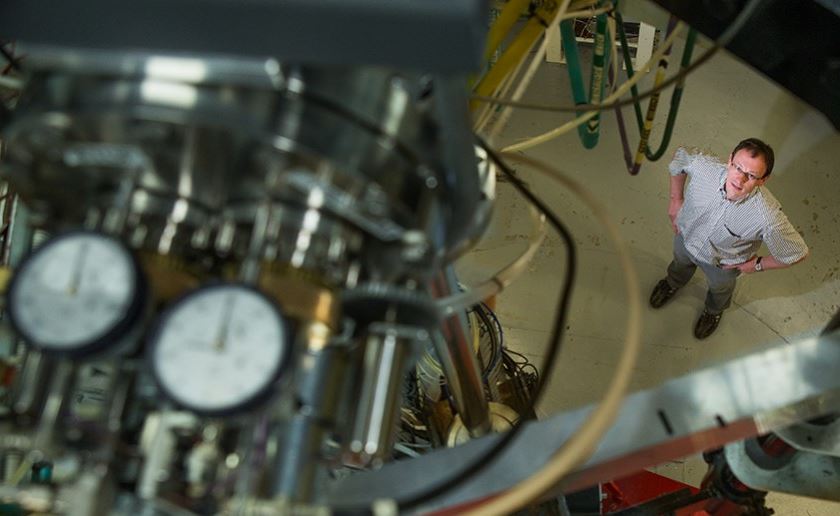A series of massive supernova explosions showered the Earth with radioactive debris a few million years ago, an international team of scientists reported, and this radioactive dust is still around. In the world of astronomy, these mega-explosions occurred nearby – but not near enough to do much damage.
The radioactive debris fell on our planet over a period of about 1.5 million years, suggesting there were a series of supernovae (the plural of ‘supernova’ is either ‘supernovas’ or ‘supernovae’).
Dr. Anton Wallner, who works at the Australian National University, and colleagues from Austria, Israel, Japan and Germany, said they found radioactive iron-60 (60Fe) in sediment and crust samples taken from the Atlantic, Pacific and Indian Oceans.
Dr. Wallner and colleagues wrote about their latest study and findings in the prestigious journal Nature (citation below).
 An artist’s impression of a massive supernova. (Image: anu.edu.au. Credit: Greg Stewart, SLAC National Accelerator Lab)
An artist’s impression of a massive supernova. (Image: anu.edu.au. Credit: Greg Stewart, SLAC National Accelerator Lab)
Astronomically-speaking, the iron-60 is fairly recent – concentrated in a period from 3.2 to 1.7 million years ago.
A number of successive supernova explosions
Dr. Wallner, a nuclear physicist at ANU’s Research School of Physics and Engineering, said:
“We were very surprised that there was debris clearly spread across 1.5 million years. It suggests there were a series of supernovae, one after another.”
“It’s an interesting coincidence that they correspond with when the Earth cooled and moved from the Pliocene into the Pleistocene period.”
The researchers also discovered evidence of iron-60 from a previous supernova about eight million years ago. This scattering of radioactive matter coincided with global faunal changes during the late Miocene.
According to some theories, cosmic rays from the supernovae may have increased cloud cover.
 A false colour image of Cassiopeia A supernova remnant. (Image: anu.edu.au. Credit: NASA/JPL-Caltech)
A false colour image of Cassiopeia A supernova remnant. (Image: anu.edu.au. Credit: NASA/JPL-Caltech)
What is a supernova?
According to NASA: “A supernova is the explosion of a star. It is the largest explosion that takes place in space.”
A supernova occurs when there is a change in the centre (core) of a star. The change can happen in two different ways – both of them resulting in a supernova:
1. In a binary star system. Binary stars are two stars orbiting the same point. One of the stars, a white dwarf, steals matter from its companion star. Eventually, this white dwarf builds up too much matter, causing it to explode in a supernova.
2. This supernova happens at the end of a single star’s life. As the star’s nuclear fuel runs out, some of its mass flows into its core. Eventually, the core becomes so dense (heavy) that it collapses in its own gravitational force. The core collapses, resulting in a giant explosion, i.e. a supernova.
Our Sun is a single star. However, it does not contain enough mass to ever become a supernova.
Supernovae 300 light years from Earth
In this latest study, the researchers concluded that the supernovae that brought radioactive debris to the Earth occurred less than 300 light years from here, which is near enough to be visible during the day, and comparable to the brightness of our Moon.
 Dr. Anton Wallner at ANU Heavy Ion Accelerator, a towering device that accelerates charged atoms to 10% of the speed of light. These speeding ‘bullets’ can then be used for a range of different studies, including some high powered materials science. (Image: anu.edu.au. Credit: Stuart Hay, ANU)
Dr. Anton Wallner at ANU Heavy Ion Accelerator, a towering device that accelerates charged atoms to 10% of the speed of light. These speeding ‘bullets’ can then be used for a range of different studies, including some high powered materials science. (Image: anu.edu.au. Credit: Stuart Hay, ANU)
Even though our planet would have been exposed to an increased cosmic ray bombardment, there would not have been enough radiation to cause direct biological damage or bring about mass extinctions.
The supernova explosions create several heavy elements and radioactive isotopes which are flung into the cosmic neighbourhood.
Iron-60 is one of these isotopes – it has a half-life of 2.6 million years, unlike its stable cousin iron-56.
All the iron-60 dating from our planet’s formation over four billion years ago has long since vanished.
The iron-60 atoms that settled on the Earth did so in tiny quantities. In order to identify the interstellar iron atoms, the scientists needed ultra-sensitive techniques.
Regarding iron-60 from space, Dr. Wallner said:
“Iron-60 from space is a million-billion times less abundant than the iron that exists naturally on Earth.”
Iron-60 detected ten years ago
Dr. Wallner initially became intrigued by the first hints of iron-60 detected in samples from the Pacific Ocean floor, discovered ten years ago by a group at the Technical University of Munich (TU Munich).
He formed an international team of scientists to search for interstellar dust from 120 ocean-floor samples spanning the last 11 million years.
First they had to extract all the iron from the ocean cores. This time-consuming task was done by two groups – one from the University of Tokyo, and the other from Helmholtz-Zentrum Dresden-Rossendorf (HZDR) in Germany.
The scientists then separated the minuscule traces of interstellar iron-60 from other terrestrial isotopes using ANU’s Heavy-Ion Accelerator and found it occurred all over the Earth.
They determined the age of the cores from the decay of other radioactive isotopes – aluminium-26 and beryllium-10 – using AMS (accelerator mass spectrometry) facilities in Germany, Japan and Austria.
According to the dating, the fallout occurred over two periods – from 3.2 to 1.7 million years ago and eight million years ago. TU Munich results agree with these findings.
Scientists at the Technical University of Berlin, in a separate study, suggested that an ageing star cluster, which has since moved away from Earth, is a possible source of the supernovae. There are no large stars left in this cluster – they have all exploded as supernovae, throwing out waves of radioactive debris.
Citation: “Recent near-Earth supernovae probed by global deposition of interstellar radioactive 60Fe,” A. Wallner, L. K. Fifield, R. Golser, P. Steier, T. Yamagata, J. Feige, N. Kinoshita, M. Paul, M. Honda, U. Linnemann, H. Matsuzaki, S. Merchel, G. Rugel, S. G. Tims & S. R. Winkler. Nature 532, 69–72. 6 April 2016. DOI: 10.1038/nature17196.
Video – Earth showered with radioactive debris from supernovae
Our planet has survived several close calls with supernovae. New research shows strong evidence that the Earth was bombarded with debris from supernova explosions at least twice over the past ten million years. Fortunately, they were too far away to do much damage.
